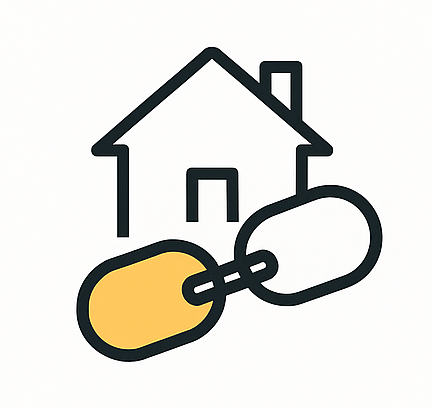This Housing Search Guide shares strategies, resources, and best practices to support households to find their home. Our goal is to support a housing search process that is clearer, quicker, and leads to lasting stability.
RLRA Housing Search Guide
Housing Search Overview
Program Intake/Orientation
Housing Preferences Identification
Barrier Identification
Housing Search
Applying to Housing
Unit Approval
Lease Signing
Move-in
This process can vary depending on the rental assistance program
Housing Search Overview + The Importance of Timelines + Where to Find the Right Fit
Steps, Timelines, and Tips
Program Intake and Orientation
Processes vary by provider - you know your processes best. Be mindful of how quick or long it typically takes.
Tip
Check to see if the household has all required documents for applying; best practice is to have government issued photo identification & income documentation
Applying for RLRA
Tip
Align your program intake process with the RLRA application requirements OR complete the RLRA application during the intake process
Steps 2-4 (applying for RLRA, identifying housing preferences, and identifying barriers) can all be done at the same time!
Identify Housing Preferences
Identifying a household’s wants and needs relies on consistent and predictable engagement from the household, but that’s not always possible. Adding this step to your intake process can save time and help get to applying quicker.
Tip
Use a questionnaire or survey to identify household preferences; download our Housing Preferences tool to use with households or create your own.
Be sure to keep in mind the maximum bedroom count and rent limit established by the rental assistance.
Identify Barriers
We can only address barriers that we know about. Performing a background and credit check for households creates understanding of their specific barriers and informs strategies to address them.
Tip
Prepare all documents needed for applying (3rd party letters of support, reasonable accommodations, program certifications, expungement records, etc.) before beginning or during housing search.
Use our Applying with Barriers: Individualized Assessment’s Guide to ensure you are doing everything possible to increase the likelihood of approval.
Housing Search
Different types of housing are often found in different places online. Competition for those units also varies. Single family homes are often harder to find and more competitive. Apartments are easier to find but often can have high barriers.
Tip
Use our Unit Search Guide to ensure households have the widest range of housing options.
Applying to Housing
Make sure that all supporting documents are submitted when applying - don’t wait for a denial! See our guide for Individualized Assessments to learn the best practices of supporting households with barriers.
Tip
As soon as the household is approved by the housing provider, email both the housing provider and Home Forward Rent Assistance Specialist to begin the required documents and schedule the inspection - CC them on the same email.
Unit Approval
Upon approval of the household, specific paperwork and an inspection are required for household’s receiving subsidy through the Housing Authority.
Tips
Download a copy of the completed documents for your record; especially the ‘Agreement for Rental Assistance’ and ‘New Rent Letter’
Inspections are not required for government subsidized Affordable Housing.
Lease Signing
Leases are complex legal documents that are hard to understand. We recommend reviewing the lease with the household prior to signing to ensure information like move-in date, rent, and security deposit amount are correct, and that they understand their responsibilities as a resident.
Tip
Use our Lease Review Worksheet with households to best support their understanding of lease compliance.
Move-in
Move-in can be an extremely rewarding but stressful time. It is also a great opportunity to build trust with both the household and housing provider.
Tips
Introduce yourself to property management in-person if possible; share contact information and what your role is to set expectations.
The housing provider may require a release of information (ROI) to share resident information like the lease, ledger, or violations - submit this on move-in day or provide it prior to move-in.
Always complete a move-in condition form and take pictures of the unit - especially important when there are existing unit damages or deficiencies.
Single Family Home to Garden Style to Highrise
Single Family Homes & Duplexes+
Single family homes, duplexes, triplexes, fourplexes. They are often hard to find, in high demand, and can have a high price. They are also often managed by the property owner who may not have the same processes or resources as a property managed by a company. Be aware that if the owner lives at the property they are not subject to some Fair Housing and landlord-tenant laws.
Single Family home rentals are most commonly found on 3rd party property management websites, Zillow, Craigslist, and Facebook Marketplace.
Small Apartment Communities
Small apartment communities can mean different things to different people, we define it as properties ranging from 5-40 units. This properties typically don’t have on-site staff and are managed by the owner or a 3rd party management company.
Small apartment communities will primarily be found on 3rd party property management websites but also can be found on Zillow, Apartments.com, Craigslist, and Facebook Marketplace. We would recommend starting with 3rd party property management websites - use our list below to get started!
Large Apartment Communities
High-rises, 5-over-1s, and the like - these are large communities ranging from 40-500+ units. These buildings often have community amenities, modern finishes, and in some cases leasing promotions. These properties are commonly managed by large regional or national property management companies.
These units are best found on Zillow and Apartments.com. Note that the properties that appear first are paying to be there - better deals sometimes can be found at the bottom, or using the map search.



